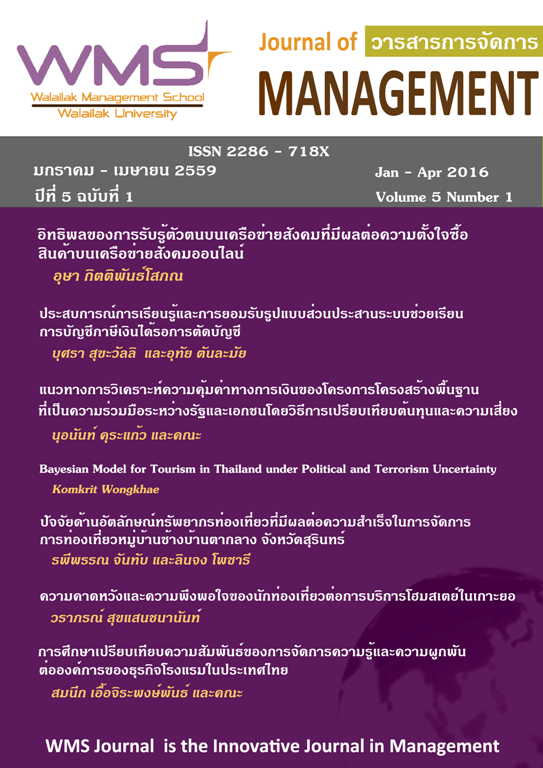The Analysis of Value-for-Money (VfM) for Public Private Partnership Infrastructure: A Public Sector Comparator Approach
Main Article Content
Abstract
Article Details
References
คงขวัญ ศิลา. (2553). ความร่วมมือภาครัฐ-ภาคเอกชน (Public Private Partnership: PPP). สืบค้นเมื่อ, 18 เมษายน 2558 สืบค้นจาก,http://www.fpo.go.th/FPO/index2.php?mod=Content&file=contentview&contentID=CNT0006003&categoryID=CAT0000146
ประกาศคณะกรรมการนโยบายการให้เอกชนร่วมลงทุนในกิจการของรัฐ. หลักเกณฑ์และวิธีการคำนวณมูลค่าของโครงการการลงทุนในกิจการของรัฐ พ.ศ. 2558. (2558).
สำนักกฎหมายธรรมนิติ http://www.dlo.co.th/node/681
Bain, R. (2010). Public sector comparators for UK PFI roads: inside the black box. Transportation, 37(3), 447-471.
Chiara, N., & Garvin, M. (2008). Variance models for project financial risk analysis with applications to greenfield BOT highway projects. Construction Management and Economics, 26 (9,2008), 925-939.
Cruz, C., & Marques, R. (2013). Public Sector Comparator Infrastructure Public-Private Partnerships, (pp. 21-51): Springer Berlin Heidelberg.
Esty, B., Narasimhan, B., & Tufano, P. (1999). Interest-rate exposure and bank mergers. Journal of Banking & Finance, 23(2–4), 255-285.
Ezzell, J. R., & Miles, J. A. (1983). Analyzing leases with the after-tax cost of debt. Journal of Business Research, 11(4), 489-499.
Flyvbjerg, B., Holm, M. S., & Buhl, S. (2003). How common and how large are cost overruns in transport infrastructure projects?.Transport Reviews, 23(1), 71-88.
Grimsey, D., & Lewis, M. K. (2002). Evaluating the risks of public private partnerships for infrastructure projects. International. Journal of Project Management, 20(2), 107-118.
Grimsey, D., & Lewis, M. K. (2005). Are Public Private Partnerships value for money?: Evaluating alternative approaches and comparing academic and practitioner views. Accounting Forum, 29(4), 345-378.
Heald, D. (2003). Value for money tests and accounting treatment in PFI schemes. Accounting, Auditing & Accountability Journal, 16(3), 342-371.
Hodge, G. A., & Greve, C. (2007). Public–Private Partnerships: An International Performance Review. Public Administration Review, 67(3), 545-558.
Khadaroo, I. (2008). The actual evaluation of school PFI bids for value for money in the UK public sector. Critical Perspectives on Accounting, 19(8), 1321-1345.
Quiggin, J. (2004). RISK, PPPs AND THE PUBLIC SECTOR COMPARATOR. Australian Accounting Review, 14(2), 51-61.
Ogunlana, S. (2003). Profitable Partnering in Construction Procurement: Taylor & Francis.
Osei-Kyei, R., & Chan, A. P. C. (2015). Review of studies on the Critical Success Factors for Public–Private Partnership (PPP) projects from 1990 to 2013. International Journal of Project Management, 33(6), 1335-1346.
Roehrich, J. K., Lewis, M. A., & George, G. (2014). Are public–private partnerships a healthy option? A systematic literature review. Social Science & Medicine, 113(0), 110-119.
Sarmento, J. M. (2010). Do Public-Private Partnerships Create Value for Money for the Public Sector? The Portuguese Experience. OECD Journal on Budgeting, 10(1), 93-119.
Sun, H., Zhou, Y., & Fan, Z.-Q. (2010, 9-10 Jan. 2010). Value for money test in infrastructure procurement. Paper presented at the Logistics Systems and Intelligent Management, 2010 International Conference on.
Vose, D. (2008). Risk Analysis: A Quantitative Guide: Wiley.
Williamson, P. J. (2010). Cost Innovation: Preparing for a ‘Value-for-Money’ Revolution. Long Range Planning, 43(2–3), 343-353.


